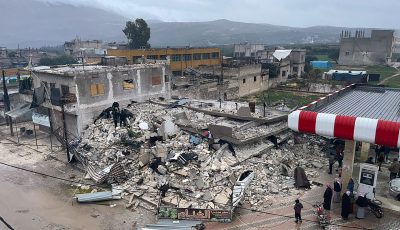Water supply enough for farmers for now

In this photo taken last January, a farmer tends to his land and crops at the Kagman commercial farm plots administered by the Department of Lands and Natural Resources-Division of Agriculture. Despite the ongoing drought, no significant drying up of crops was reported yet, according to DLNR Secretary Richard Seman. (Frauleine Villanueva-Dizon)
Despite the current drought becoming worse in Micronesia, farmers on Saipan have adequate water supply for now, according to Department of Lands and Natural Resources Secretary Richard Seman.
“Right now we’re doing okay, but it might get worse,” Seman said.
Asked if they have noticed any plants or crops drying or yellowing up because of the heat, Seman said they haven’t seen such incidences yet.
“Not yet at this point but I’m pretty sure that if it doesn’t rain between now and next month, we’ll start seeing some effect of this drought,” Seman said.
“So far we’re getting little but at least some consistent rain,” he added.
Seman said they are closely monitoring farmers and ensuring that their water sources are working.
“We’re making sure that all of our wells and pumps are up and running,” Seman said.
Last January and since Typhoon Soudelor, wells servicing the land at the Kagman commercial farm plots encountered several problems including low production and control panel issues.
DLNR-Division of Agriculture director Manny Tenorio said in a prior interview that there were only three wells working at the time.
Tenorio said pumps are supposed to last up to five years, but because of the sediments in the water, the pumps usually corrode and deteriorate easily.
They spend about $3,000 to $4,000 per pump water replacement. Each well can push up to 30 to 35 gallons per minute.
According to Seman, the five wells dedicated to the commercial farm plots are now working.
“They are all working now,” Seman said.
To ensure that the farmers’ source of water will not be interrupted, Seman said back-up pumps are being procured.
“The governor is also procuring five more for backup,” Seman said.
According to Tenorio, farmers use untreated water directly from wells which are good for the plants and can use up to 40,000 gallons of water. They pay $10 per month per farm turnout.
Because pumps sometimes break down and coupled with the ongoing drought, Tenorio said he encourages farmers to build and have their own tanks for water storage.
“I encourage people to apply with U.S Department of Agriculture’s Natural Resources Conservation Service, the Environmental Quality Incentives Program, to build tanks,” Tenorio said.
“Go and apply, you have nothing to lose. This is for you to have water, without water your crops are dead,” he added.



























